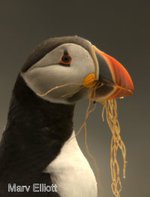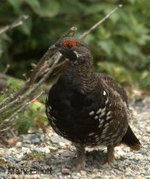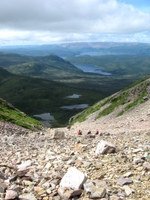Marv and I usually choose our vacation destinations with birding in mind so Newfoundland seemed like just the place for this summer’s adventure. A place whose provincial bird is the Atlantic Puffin had to be good. Besides the provincial flower is the carnivorous pitcher plant, it has geographical features called  Atlantic Puffintickles and bights, food items such as bakeapples and cod cheeks, place names like Ha Ha Bay, Cow Head, and Happy Adventure, and a quirky time zone. It was intriguing. Newfoundland doesn’t rival Texas or southeast Arizona in number of species, but it does have a number of seabirds not found in southern locations. It also provides the opportunity to see those birds and other species in their breeding habitats. Even without birds, we would have enjoyed Newfoundland immensely. And the birds were wonderful.
Atlantic Puffintickles and bights, food items such as bakeapples and cod cheeks, place names like Ha Ha Bay, Cow Head, and Happy Adventure, and a quirky time zone. It was intriguing. Newfoundland doesn’t rival Texas or southeast Arizona in number of species, but it does have a number of seabirds not found in southern locations. It also provides the opportunity to see those birds and other species in their breeding habitats. Even without birds, we would have enjoyed Newfoundland immensely. And the birds were wonderful.
Newfoundland can be reached by air or ferry, but by arriving by water you get the sense of arriving at a “New Founde Lande,” an island known as “The Rock.” It also gives you the opportunity for a little pelagic birding. We were fortunate to run into a group from the Brookline Bird Club in Massachusetts and spent a good portion of the trip on the bow taking advantage of their seabird expertise. New birds for us on the 100-miles crossing of the Cabot Strait from North Sidney, Nova Scotia to Port aux Basques, Newfoundland included Common and Manx shearwaters, Northern Fulmar, and Leach’s Storm-petrel. At 8 inches the storm-petrel seems a surprisingly small bird for such a large expanse of water. Northern Gannets were also present in good numbers and their plunge diving is fun to watch. Any feelings of seasickness were quickly dissipated!
We spent the first seven days on the west coast of Newfoundland at Gros Morne National Park. T Spruce Grousehe park consists of rocky coastline, stunted spruce forest called tuckamore, bogs, and high elevation arctic-alpine habitat. Something for everyone and every bird! There we saw Gray Jay, Boreal Chickadee, Spruce Grouse and Black-backed Woodpecker. Other northern species included Olive-sided and Yellow-bellied flycatchers, Swainson’s Thrush, Blackpoll Warbler and Lincoln’s Sparrow. Shorebirds included Ruddy Turnstone and Semipalmated Plover. We saw Arctic Terns for the first time and saw female Common Eiders snoozing on rocks with their young.
Spruce Grousehe park consists of rocky coastline, stunted spruce forest called tuckamore, bogs, and high elevation arctic-alpine habitat. Something for everyone and every bird! There we saw Gray Jay, Boreal Chickadee, Spruce Grouse and Black-backed Woodpecker. Other northern species included Olive-sided and Yellow-bellied flycatchers, Swainson’s Thrush, Blackpoll Warbler and Lincoln’s Sparrow. Shorebirds included Ruddy Turnstone and Semipalmated Plover. We saw Arctic Terns for the first time and saw female Common Eiders snoozing on rocks with their young.
 Gray JayBird behavior is always fun to watch. While waiting on a dock for a boat tour, we were greeted by Gray Jays. The Canadian Gray Jays are as comical and sometimes bad mannered as their U.S. counterparts, systematically making the begging rounds as new passengers arrived, with occasional stops to peer into trash barrels.
Gray JayBird behavior is always fun to watch. While waiting on a dock for a boat tour, we were greeted by Gray Jays. The Canadian Gray Jays are as comical and sometimes bad mannered as their U.S. counterparts, systematically making the begging rounds as new passengers arrived, with occasional stops to peer into trash barrels.
The highlight of the week was a trip to the top of Gros Morne Mountain. A friend of ours will be receiving the “Understatement of the Year Award.” When asked about the hike, he replied, “It wasn’t too bad.” At 806 meters (that’s 2,644 feet for the  climbing Gros Mornemetrically-challenged), the grueling hike of 16 kilometers, which sounds more impressive than ten miles, resulted in magnificent views and a life bird. The Rock Ptarmigan, usually found much further north on the rocky arctic tundra, is the birders’ target at Gros Morne. We had excellent views of three females and seven soon-to-be teenagers. Good thing because after that hike we weren't about to descend without seeing one! A digital disaster has prevented us showing you a photo so here is one of Roy Pilcher’s so you get the idea.
climbing Gros Mornemetrically-challenged), the grueling hike of 16 kilometers, which sounds more impressive than ten miles, resulted in magnificent views and a life bird. The Rock Ptarmigan, usually found much further north on the rocky arctic tundra, is the birders’ target at Gros Morne. We had excellent views of three females and seven soon-to-be teenagers. Good thing because after that hike we weren't about to descend without seeing one! A digital disaster has prevented us showing you a photo so here is one of Roy Pilcher’s so you get the idea. Rock Ptarmigan (male)
Rock Ptarmigan (male)
Stay tuned for more including the puffins....